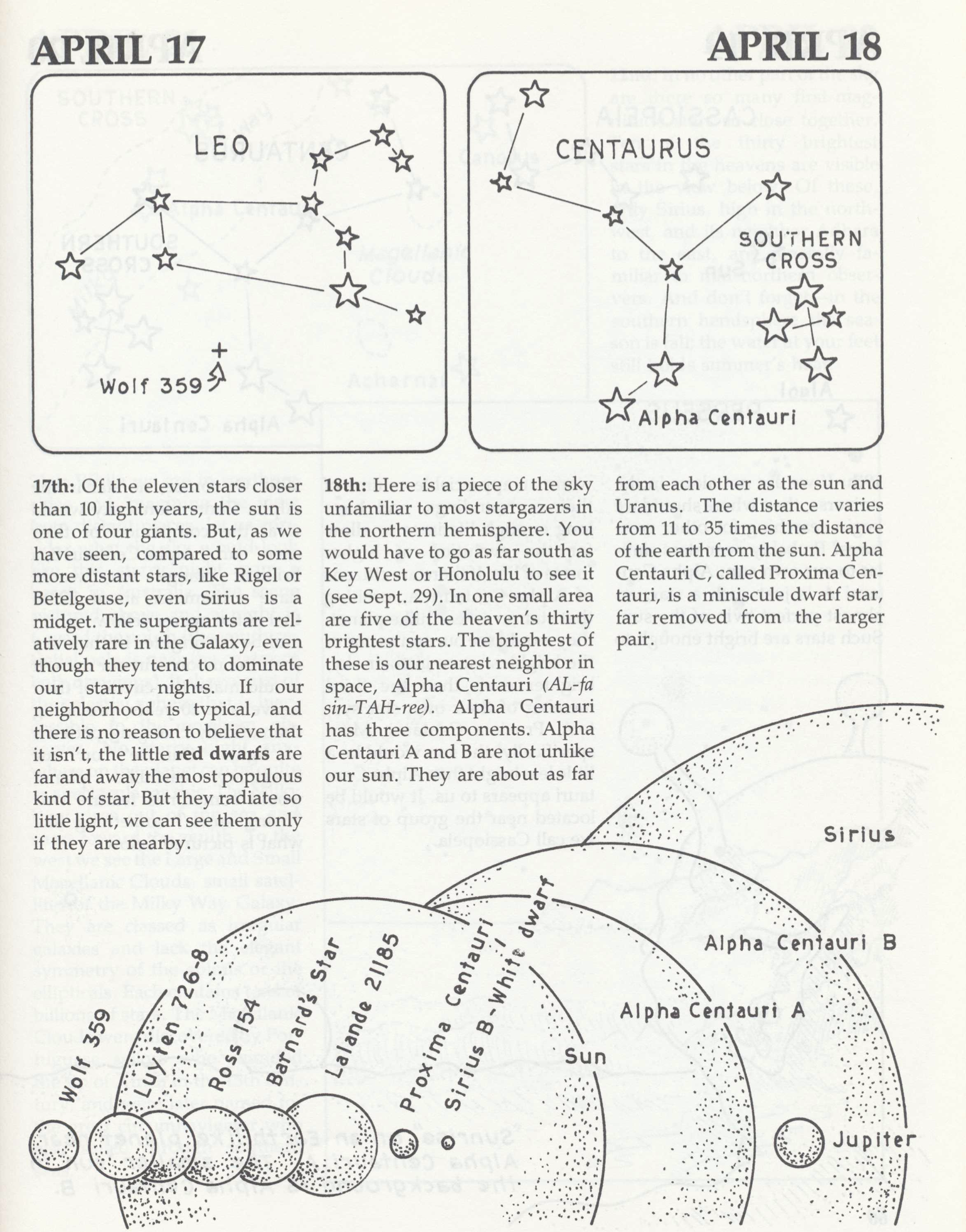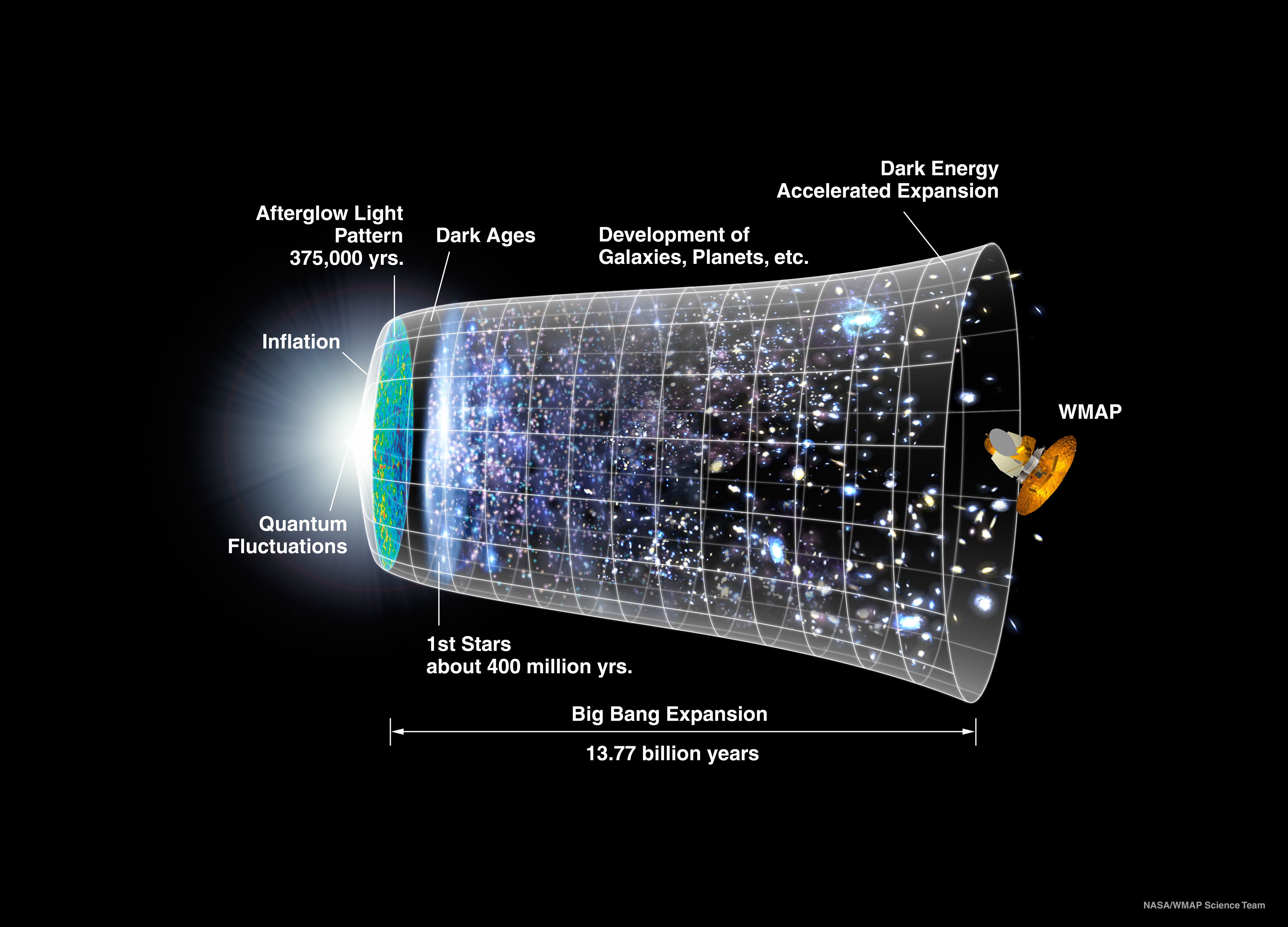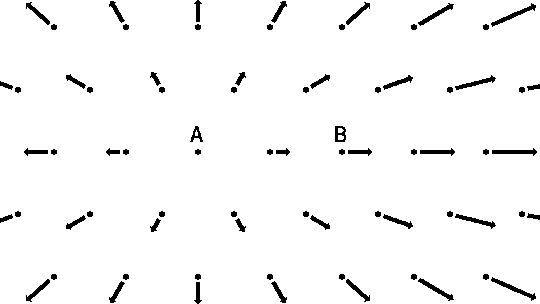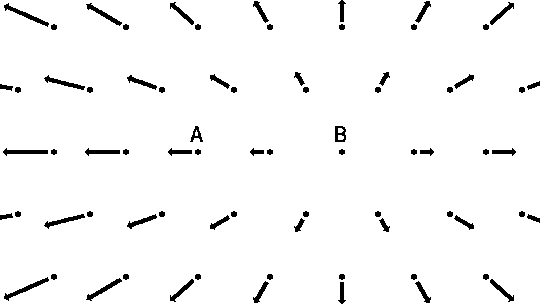Quoting from Alan Lightman's, "A Modern Day Yankee In A
Connecticut Court and other essays on Science".
Conversations with Papa Joe
The Second Evening
Read: Conversations_with_Papa_Joe_II.pdf
Listen: Conversations_with_Papa_Joe_II.mp3
Key Words and Phrases:
Galaxies
Redshift
Expansion of the Universe
Spectrometer
Big Bang - Tests of the big bang theory
Earth younger than the universe
Radioactivity - Radio dating
Multiple independent measurements

HOW DO WE DETERMIN AGE (Bones, Earth, Solar System)
Wikipedia -- Radiometric Dating
https://en.wikipedia.org/wiki/Radiometric_dating
https://en.wikipedia.org/wiki/Radiocarbon_dating
Radiometric dating, radioactive dating or radioisotope
dating is a technique which is used to date materials such
as rocks or carbon, in which trace radioactive impurities
were selectively incorporated when they were formed. The
method compares the abundance of a naturally occurring
radioactive isotope within the material to the abundance of
its decay products, which form at a known constant rate of
decay. The use of radiometric dating was first published in
1907 by Bertram Boltwood and is now the principal source of
information about the absolute age of rocks and other
geological features, including the age of fossilized life
forms or the age of the Earth itself, and can also be used
to date a wide range of natural and man-made materials.
Together with stratigraphic principles, radiometric dating
methods are used in geochronology to establish the geologic
time scale. Among the best-known techniques are radiocarbon
dating, potassium-argon dating and uranium-lead dating. By
allowing the establishment of geological timescales, it
provides a significant source of information about the ages
of fossils and the deduced rates of evolutionary change.
Radiometric dating is also used to date archaeological
materials, including ancient artifacts.
Wikipedia -- Chondrite
https://en.wikipedia.org/wiki/Chondrite
Chondrites were formed by the accretion of particles of dust
and grit present in the primitive Solar System which gave
rise to asteroids over 4.54 billion years ago. These
asteroid parent bodies of chondrites are (or were) small to
medium-sized asteroids that were never part of any body
large enough to undergo melting and planetary
differentiation. Dating using 206Pb/204Pb gives an estimated
age of 4,566.6 +/- 1.0 Ma, matching ages for other
chronometers. Another indication of their age is the fact
that the abundance of non-volatile elements in chondrites is
similar to that found in the atmosphere of the Sun and other
stars in our galaxy.
Although chondritic asteroids never became hot enough to
melt based upon internal temperatures, many of them reached
high enough temperatures that they experienced significant
thermal metamorphism in their interiors. The source of the
heat was most likely energy coming from the decay of
short-lived radioisotopes (half-lives less than a few
million years) that were present in the newly formed solar
system, especially 26Al and 60Fe, although heating may have
been caused by impacts onto the asteroids as well. Many
chondritic asteroids also contained significant amounts of
water, possibly due to the accretion of ice along with rocky
material.
BIG BANG COSMOLOGY
 Tests of Big Bang Cosmology
https://map.gsfc.nasa.gov/universe/bb_tests.html
https://map.gsfc.nasa.gov/universe/bb_tests_exp.html
The Big Bang Model is supported by a number of important
observations, each of which are described in more detail on
separate pages:
The expansion of the universe
Edwin Hubble's 1929 observation that galaxies were
generally receding from us provided the first clue that
the Big Bang theory might be right.
The abundance of the light elements H, He, Li
The Big Bang theory predicts that these light elements
should have been fused from protons and neutrons in the
first few minutes after the Big Bang.
The cosmic microwave background (CMB) radiation
The early universe should have been very hot. The cosmic
microwave background radiation is the remnant heat
leftover from the Big Bang.
These three measurable signatures strongly support the
notion that the universe evolved from a dense, nearly
featureless hot gas, just as the Big Bang model predicts.
_____________________
The Big Bang model was a natural outcome of Einstein's
General Relativity as applied to a homogeneous universe.
However, in 1917, the idea that the universe was expanding
was thought to be absurd. So Einstein invented the
cosmological constant as a term in his General Relativity
theory that allowed for a static universe. In 1929, Edwin
Hubble announced that his observations of galaxies outside
our own Milky Way showed that they were systematically
moving away from us with a speed that was proportional to
their distance from us. The more distant the galaxy, the
faster it was receding from us. The universe was expanding
after all, just as General Relativity originally predicted!
Hubble observed that the light from a given galaxy was
shifted further toward the red end of the light spectrum the
further that galaxy was from our galaxy.
The specific form of Hubble's expansion law is important:
the speed of recession is proportional to distance. Hubble
expressed this idea in an equation - distance/time per
megaparsec. A megaparsec is a really big distance
(3.26 million light-years).
The expanding raisin bread model illustrates why this
proportion law is important. If every portion of the bread
expands by the same amount in a given interval of time, then
the raisins would recede from each other with exactly a
Hubble type expansion law.
In a given time interval, a nearby raisin would move
relatively little, but a distant raisin would move
relatively farther - and the same behavior would be seen
from any raisin in the loaf. In other words, the Hubble law
is just what one would expect for a homogeneous expanding
universe, as predicted by the Big Bang theory.
Moreover no galaxy, occupies a special place in this
universe. Every observer appears to be at the center of the
expansion.
Tests of Big Bang Cosmology
https://map.gsfc.nasa.gov/universe/bb_tests.html
https://map.gsfc.nasa.gov/universe/bb_tests_exp.html
The Big Bang Model is supported by a number of important
observations, each of which are described in more detail on
separate pages:
The expansion of the universe
Edwin Hubble's 1929 observation that galaxies were
generally receding from us provided the first clue that
the Big Bang theory might be right.
The abundance of the light elements H, He, Li
The Big Bang theory predicts that these light elements
should have been fused from protons and neutrons in the
first few minutes after the Big Bang.
The cosmic microwave background (CMB) radiation
The early universe should have been very hot. The cosmic
microwave background radiation is the remnant heat
leftover from the Big Bang.
These three measurable signatures strongly support the
notion that the universe evolved from a dense, nearly
featureless hot gas, just as the Big Bang model predicts.
_____________________
The Big Bang model was a natural outcome of Einstein's
General Relativity as applied to a homogeneous universe.
However, in 1917, the idea that the universe was expanding
was thought to be absurd. So Einstein invented the
cosmological constant as a term in his General Relativity
theory that allowed for a static universe. In 1929, Edwin
Hubble announced that his observations of galaxies outside
our own Milky Way showed that they were systematically
moving away from us with a speed that was proportional to
their distance from us. The more distant the galaxy, the
faster it was receding from us. The universe was expanding
after all, just as General Relativity originally predicted!
Hubble observed that the light from a given galaxy was
shifted further toward the red end of the light spectrum the
further that galaxy was from our galaxy.
The specific form of Hubble's expansion law is important:
the speed of recession is proportional to distance. Hubble
expressed this idea in an equation - distance/time per
megaparsec. A megaparsec is a really big distance
(3.26 million light-years).
The expanding raisin bread model illustrates why this
proportion law is important. If every portion of the bread
expands by the same amount in a given interval of time, then
the raisins would recede from each other with exactly a
Hubble type expansion law.
In a given time interval, a nearby raisin would move
relatively little, but a distant raisin would move
relatively farther - and the same behavior would be seen
from any raisin in the loaf. In other words, the Hubble law
is just what one would expect for a homogeneous expanding
universe, as predicted by the Big Bang theory.
Moreover no galaxy, occupies a special place in this
universe. Every observer appears to be at the center of the
expansion.

 Wikipedia -- Spectral line
https://en.wikipedia.org/wiki/Spectral_line
A spectral line is a dark or bright line in an otherwise
uniform and continuous spectrum, resulting from emission or
absorption of light in a narrow frequency range, compared
with the nearby frequencies. Spectral lines are often used
to identify atoms and molecules. These "fingerprints" can be
compared to the previously collected "fingerprints" of atoms
and molecules, and are thus used to identify the atomic and
molecular components of stars and planets, which would
otherwise be impossible.
Spectroscopy 101 - Types of Spectra and Spectroscopy
https://webbtelescope.org/contents/articles/spectroscopy-101--types-of-spectra-and-spectroscopy
The basic premise of spectroscopy is that different
materials emit and interact with different wavelengths
(colors) of light in different ways, depending on properties
like temperature and composition. We can therefore use
spectra-the detailed patterns of colors-to figure out things
like exactly how hot something is and exactly what elements
and compounds it is made of, without ever sampling it
directly.
Wikipedia -- Doppler Effect (Redshift)
https://en.wikipedia.org/wiki/Doppler_effect
https://en.wikipedia.org/wiki/Redshift
In physics, redshift is a phenomenon where electromagnetic
radiation (such as light) from an object undergoes an
increase in wavelength. Whether or not the radiation is
visible, "redshift" means an increase in wavelength,
equivalent to a decrease in wave frequency and photon
energy, in accordance with, respectively, the wave and
quantum theories of light.
There are three main causes of redshifts in astronomy and
cosmology:
1. Objects move apart (or closer together) in space. This
is an example of the Doppler effect.
2. Space itself is expanding, causing objects to become
separated without changing their positions in space. This
is known as cosmological redshift. All sufficiently
distant light sources (generally more than a few million
light-years away) show redshift corresponding to the rate
of increase in their distance from Earth, known as
Hubble's law.
3. Gravitational redshift is a relativistic effect
observed due to strong gravitational fields, which distort
spacetime and exert a force on light and other particles.
Knowledge of redshifts and blueshifts has been used to
develop several terrestrial technologies such as Doppler
radar and radar guns. Redshifts are also seen in the
spectroscopic observations of astronomical objects. Its
value is represented by the letter z.
Wikipedia -- Spectral line
https://en.wikipedia.org/wiki/Spectral_line
A spectral line is a dark or bright line in an otherwise
uniform and continuous spectrum, resulting from emission or
absorption of light in a narrow frequency range, compared
with the nearby frequencies. Spectral lines are often used
to identify atoms and molecules. These "fingerprints" can be
compared to the previously collected "fingerprints" of atoms
and molecules, and are thus used to identify the atomic and
molecular components of stars and planets, which would
otherwise be impossible.
Spectroscopy 101 - Types of Spectra and Spectroscopy
https://webbtelescope.org/contents/articles/spectroscopy-101--types-of-spectra-and-spectroscopy
The basic premise of spectroscopy is that different
materials emit and interact with different wavelengths
(colors) of light in different ways, depending on properties
like temperature and composition. We can therefore use
spectra-the detailed patterns of colors-to figure out things
like exactly how hot something is and exactly what elements
and compounds it is made of, without ever sampling it
directly.
Wikipedia -- Doppler Effect (Redshift)
https://en.wikipedia.org/wiki/Doppler_effect
https://en.wikipedia.org/wiki/Redshift
In physics, redshift is a phenomenon where electromagnetic
radiation (such as light) from an object undergoes an
increase in wavelength. Whether or not the radiation is
visible, "redshift" means an increase in wavelength,
equivalent to a decrease in wave frequency and photon
energy, in accordance with, respectively, the wave and
quantum theories of light.
There are three main causes of redshifts in astronomy and
cosmology:
1. Objects move apart (or closer together) in space. This
is an example of the Doppler effect.
2. Space itself is expanding, causing objects to become
separated without changing their positions in space. This
is known as cosmological redshift. All sufficiently
distant light sources (generally more than a few million
light-years away) show redshift corresponding to the rate
of increase in their distance from Earth, known as
Hubble's law.
3. Gravitational redshift is a relativistic effect
observed due to strong gravitational fields, which distort
spacetime and exert a force on light and other particles.
Knowledge of redshifts and blueshifts has been used to
develop several terrestrial technologies such as Doppler
radar and radar guns. Redshifts are also seen in the
spectroscopic observations of astronomical objects. Its
value is represented by the letter z.
BOOK RECOMMENDATION:
The Age of the Earth
by G. Brent Dalrymple
https://www.amazon.com/Age-Earth-G-Brent-Dalrymple/dp/0804723311
This is a definitive, masterly history and synthesis of all
that has been said (by theologians and scientists) and is
known (to science) about the question, How old is the Earth?
It explains in a simple and straightforward way the evidence
and logic that have led scientists to conclude that the
Earth and the other parts of the Solar System are not
several thousand years old, as some today would have it, but
four and one-half billion years old.
It is a fascinating story, but not so simple as single
measurement. Our universe is a large, old, and complicated
place. Earth and other bodies have endured a long and
sometimes violent history, the events of which have
frequently obscured the record that we seek to decipher.
Although in detail the journey into Earth's past requires
considerable scientific skill, knowledge, and imagination,
the story is not so complicated that it cannot be explained
to someone who wants to know and understand the basic
evidence. This book, then, has been written for people with
some modest background in science, but at a level that will
allow the material to be useful and accessible to those
without a deep knowledge of geology or physics or
mathematics.
The First Three Minutes: A Modern View of the Origin of
the Universe
by Steven Weinberg
https://www.amazon.com/First-Three-Minutes-Modern-Universe/dp/0465024378
"The book is the first I have seen to put the details, both
historical and conceptual, of the origin of the Universe
within the grasp of the general reader... As such, it is a
tremendous service to us all."
~Isaac Asimov
"His book is science writing at its best."
~Martin Gardner, New York Review of Books
"Weinberg builds such a convincing case...that one comes
away from his book feeling not only that the idea of an
original cosmic explosion is not crazy but that any other
theory appears scientifically irrational."
~Jeremy Bernstein, New Yorker
"A most remarkable achievement...presented with
clarity...and great scientific accuracy."
~T.D. Lee, Nobel Laureate in Physics
WEBSITE RECOMMENDATION:
Astronomy Picture of the Day
https://apod.nasa.gov/apod/astropix.html
Astronomy Picture of the Day (APOD) is originated, written,
coordinated, and edited since 1995 by Robert Nemiroff and
Jerry Bonnell. The APOD archive contains the largest
collection of annotated astronomical images on the internet.
APOD in general and the APOD site served from NASA
specifically places links solely on information content and
does not endorse any commercial product nor guarantee claims
or sales made on any linked pages.
In real life, Bob and Jerry are two professional astronomers
who spend most of their time researching the universe. Bob
is a professor at Michigan Technological University in
Houghton, Michigan, USA, while Jerry is a scientist at
NASA's Goddard Space Flight Center in Greenbelt, Maryland
USA. They are two married, mild and lazy guys who might
appear relatively normal to an unsuspecting guest. Together,
they have found new and unusual ways of annoying people such
as staging astronomical debates. Most people are surprised
to learn that they have developed the perfect random number
generator.
sam.wormley@icloud.com

Tests of Big Bang Cosmology https://map.gsfc.nasa.gov/universe/bb_tests.html https://map.gsfc.nasa.gov/universe/bb_tests_exp.html The Big Bang Model is supported by a number of important observations, each of which are described in more detail on separate pages: The expansion of the universe Edwin Hubble's 1929 observation that galaxies were generally receding from us provided the first clue that the Big Bang theory might be right. The abundance of the light elements H, He, Li The Big Bang theory predicts that these light elements should have been fused from protons and neutrons in the first few minutes after the Big Bang. The cosmic microwave background (CMB) radiation The early universe should have been very hot. The cosmic microwave background radiation is the remnant heat leftover from the Big Bang. These three measurable signatures strongly support the notion that the universe evolved from a dense, nearly featureless hot gas, just as the Big Bang model predicts. _____________________ The Big Bang model was a natural outcome of Einstein's General Relativity as applied to a homogeneous universe. However, in 1917, the idea that the universe was expanding was thought to be absurd. So Einstein invented the cosmological constant as a term in his General Relativity theory that allowed for a static universe. In 1929, Edwin Hubble announced that his observations of galaxies outside our own Milky Way showed that they were systematically moving away from us with a speed that was proportional to their distance from us. The more distant the galaxy, the faster it was receding from us. The universe was expanding after all, just as General Relativity originally predicted! Hubble observed that the light from a given galaxy was shifted further toward the red end of the light spectrum the further that galaxy was from our galaxy. The specific form of Hubble's expansion law is important: the speed of recession is proportional to distance. Hubble expressed this idea in an equation - distance/time per megaparsec. A megaparsec is a really big distance (3.26 million light-years). The expanding raisin bread model illustrates why this proportion law is important. If every portion of the bread expands by the same amount in a given interval of time, then the raisins would recede from each other with exactly a Hubble type expansion law. In a given time interval, a nearby raisin would move relatively little, but a distant raisin would move relatively farther - and the same behavior would be seen from any raisin in the loaf. In other words, the Hubble law is just what one would expect for a homogeneous expanding universe, as predicted by the Big Bang theory. Moreover no galaxy, occupies a special place in this universe. Every observer appears to be at the center of the expansion.

Wikipedia -- Spectral line https://en.wikipedia.org/wiki/Spectral_line A spectral line is a dark or bright line in an otherwise uniform and continuous spectrum, resulting from emission or absorption of light in a narrow frequency range, compared with the nearby frequencies. Spectral lines are often used to identify atoms and molecules. These "fingerprints" can be compared to the previously collected "fingerprints" of atoms and molecules, and are thus used to identify the atomic and molecular components of stars and planets, which would otherwise be impossible. Spectroscopy 101 - Types of Spectra and Spectroscopy https://webbtelescope.org/contents/articles/spectroscopy-101--types-of-spectra-and-spectroscopy The basic premise of spectroscopy is that different materials emit and interact with different wavelengths (colors) of light in different ways, depending on properties like temperature and composition. We can therefore use spectra-the detailed patterns of colors-to figure out things like exactly how hot something is and exactly what elements and compounds it is made of, without ever sampling it directly. Wikipedia -- Doppler Effect (Redshift) https://en.wikipedia.org/wiki/Doppler_effect https://en.wikipedia.org/wiki/Redshift In physics, redshift is a phenomenon where electromagnetic radiation (such as light) from an object undergoes an increase in wavelength. Whether or not the radiation is visible, "redshift" means an increase in wavelength, equivalent to a decrease in wave frequency and photon energy, in accordance with, respectively, the wave and quantum theories of light. There are three main causes of redshifts in astronomy and cosmology: 1. Objects move apart (or closer together) in space. This is an example of the Doppler effect. 2. Space itself is expanding, causing objects to become separated without changing their positions in space. This is known as cosmological redshift. All sufficiently distant light sources (generally more than a few million light-years away) show redshift corresponding to the rate of increase in their distance from Earth, known as Hubble's law. 3. Gravitational redshift is a relativistic effect observed due to strong gravitational fields, which distort spacetime and exert a force on light and other particles. Knowledge of redshifts and blueshifts has been used to develop several terrestrial technologies such as Doppler radar and radar guns. Redshifts are also seen in the spectroscopic observations of astronomical objects. Its value is represented by the letter z.